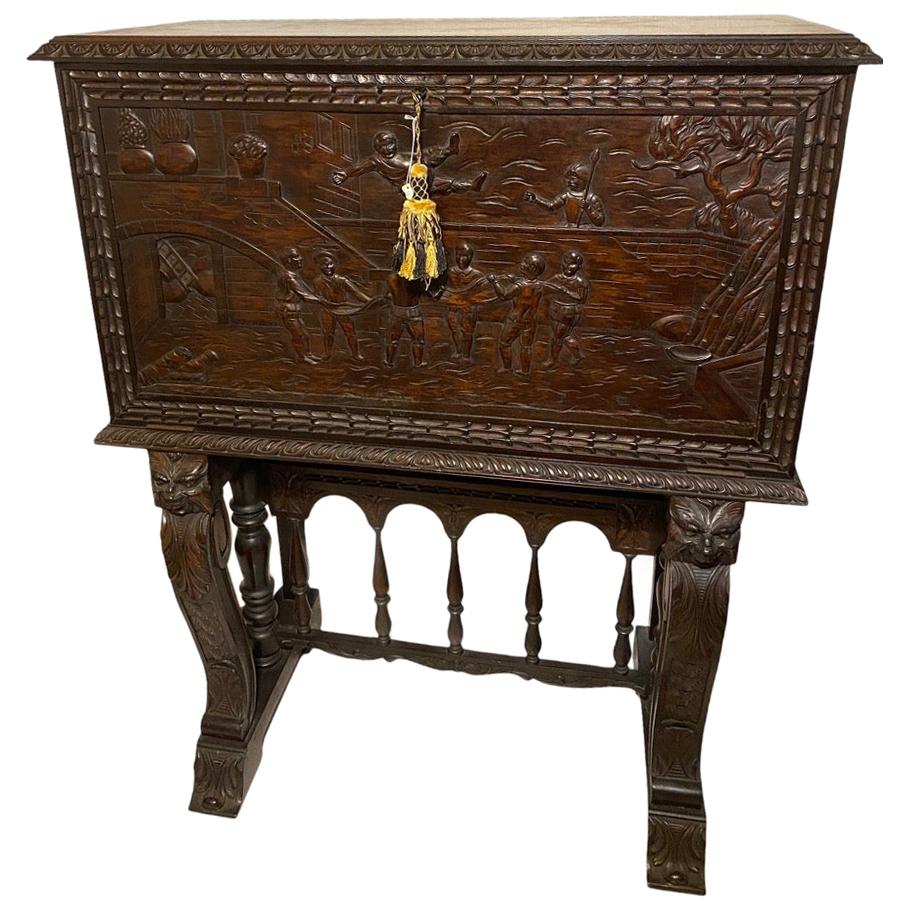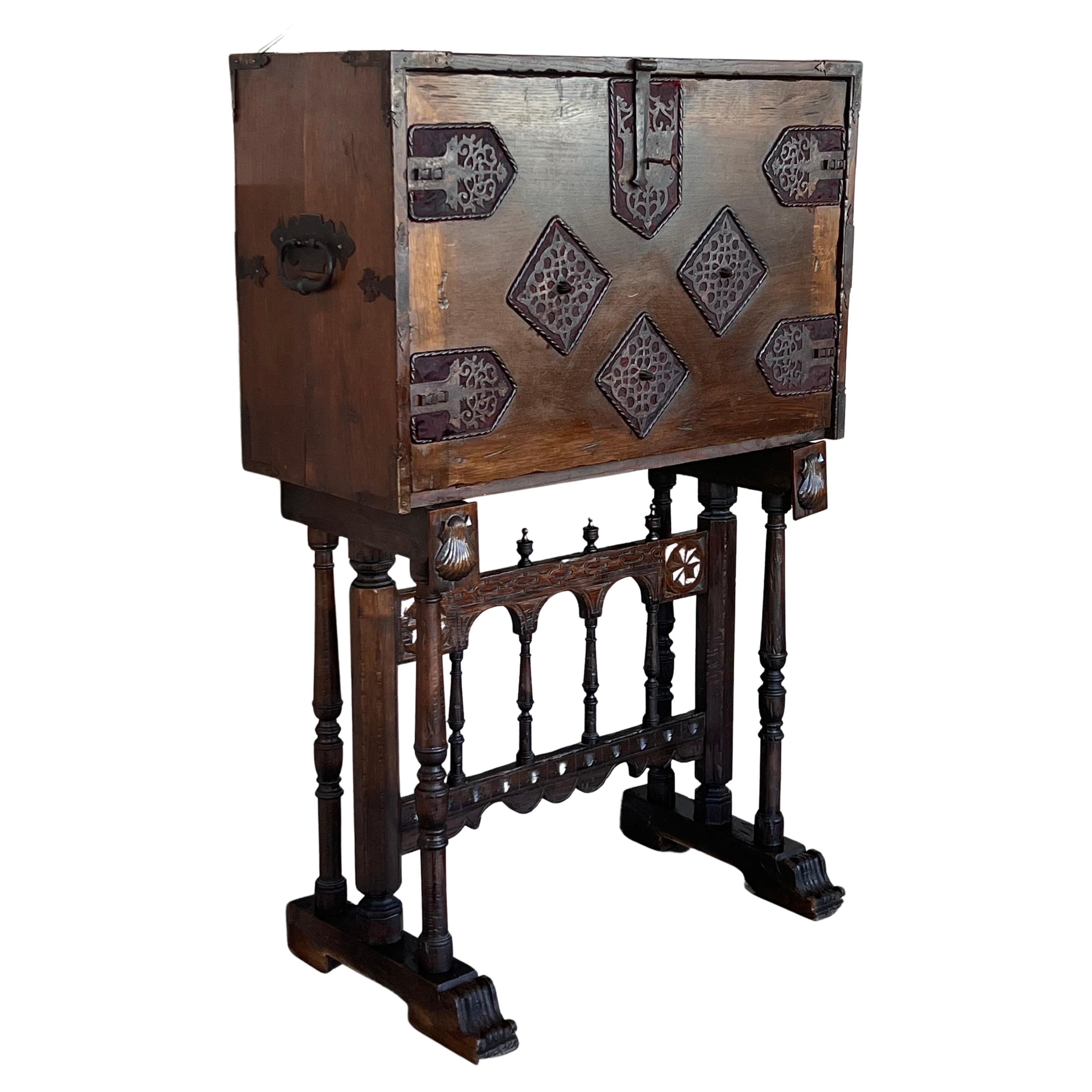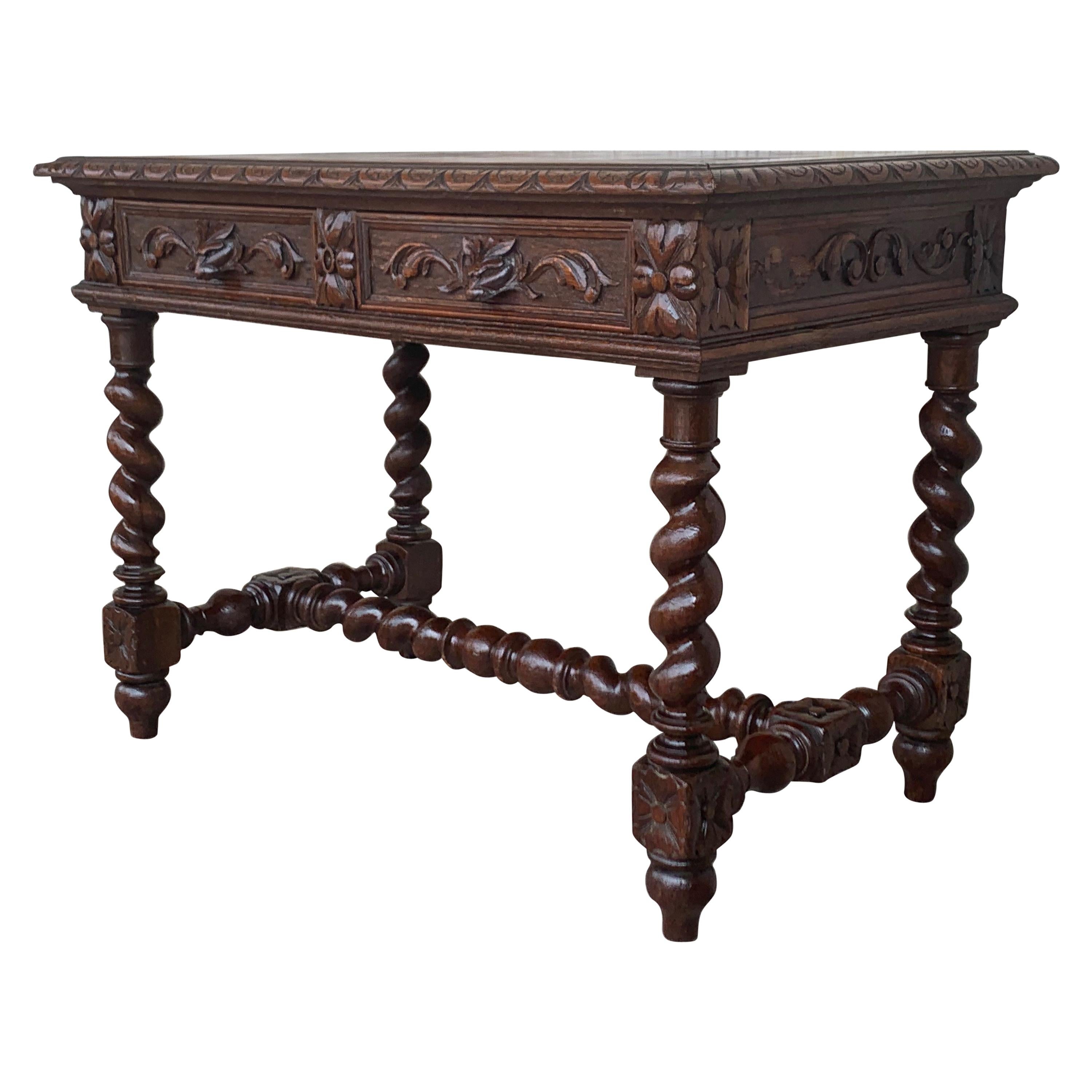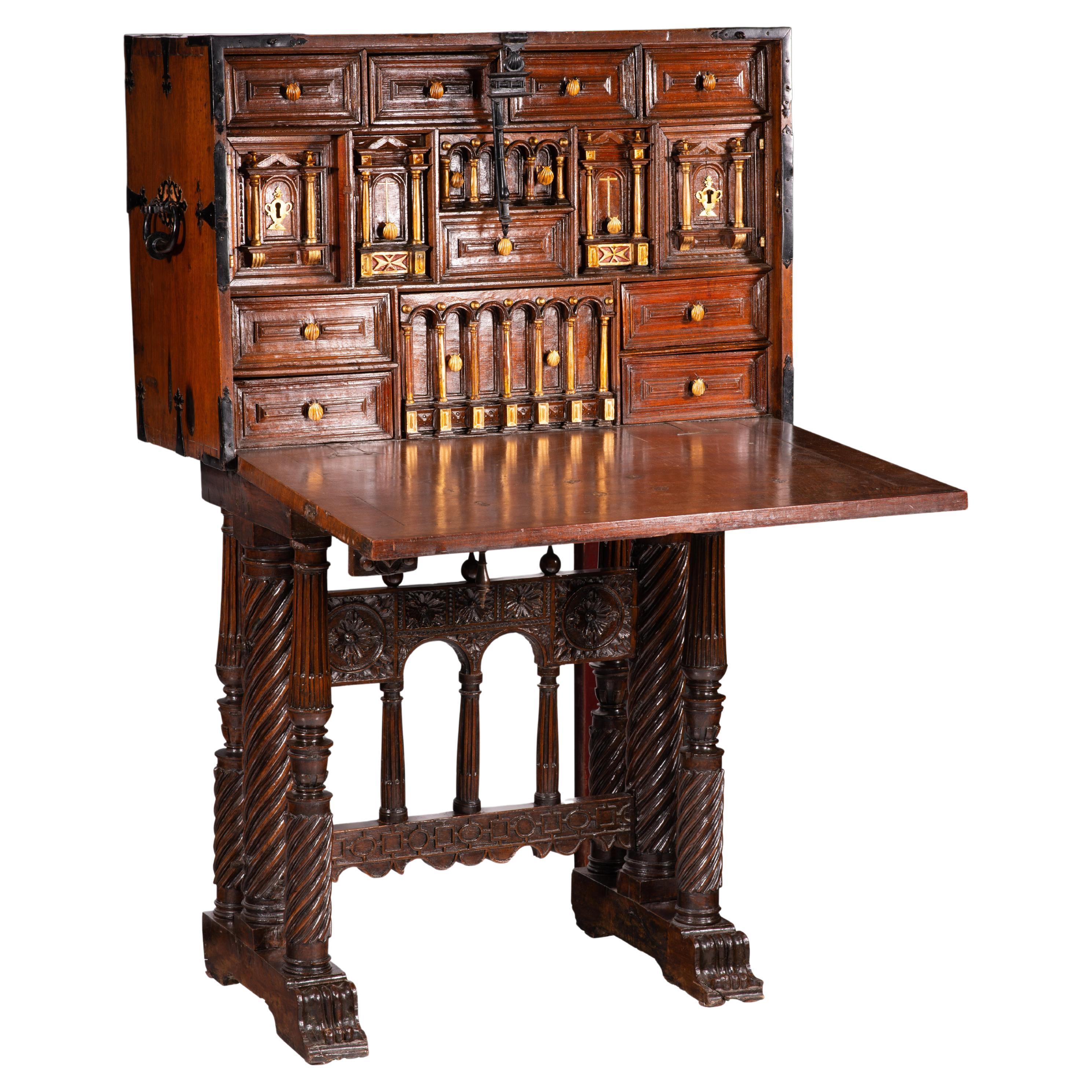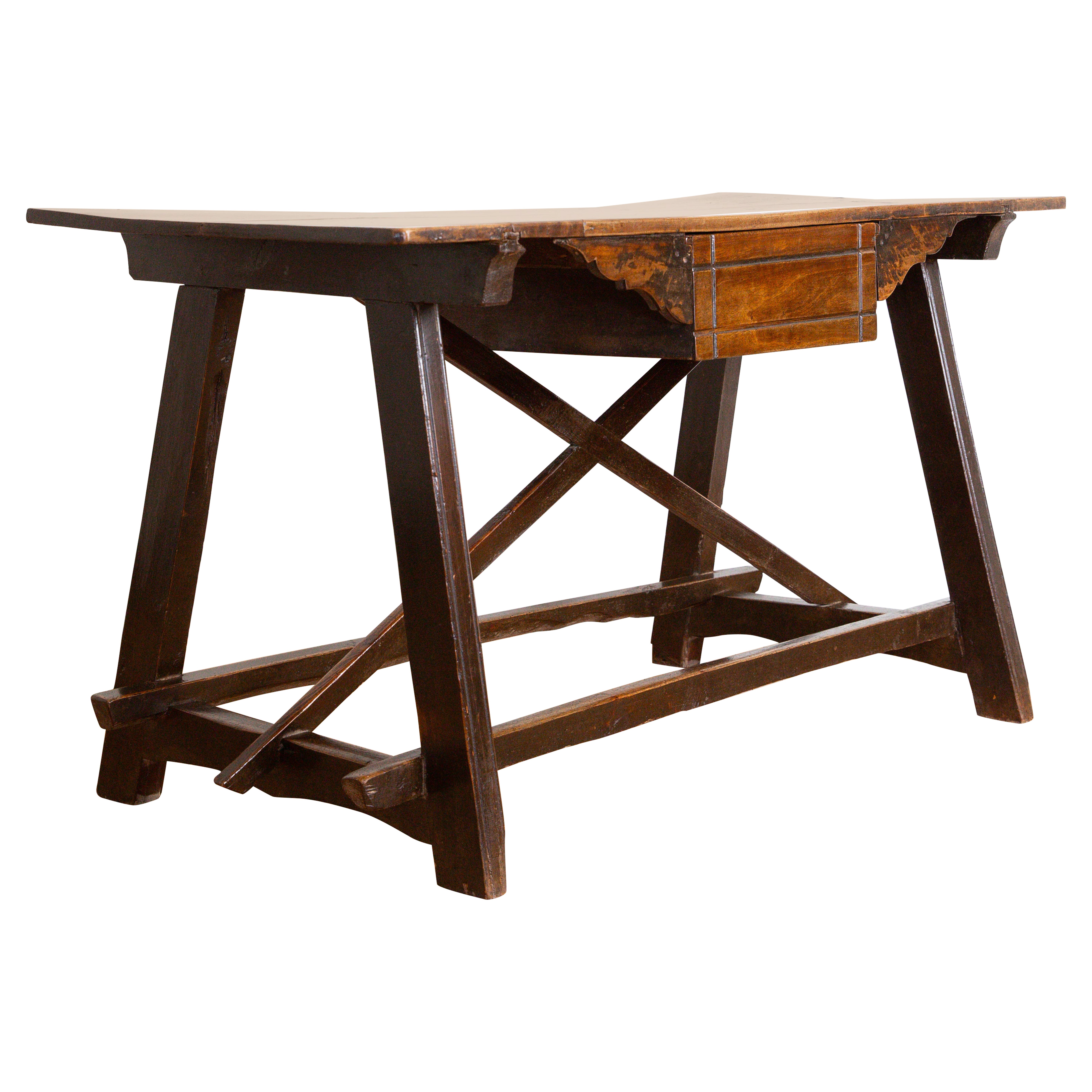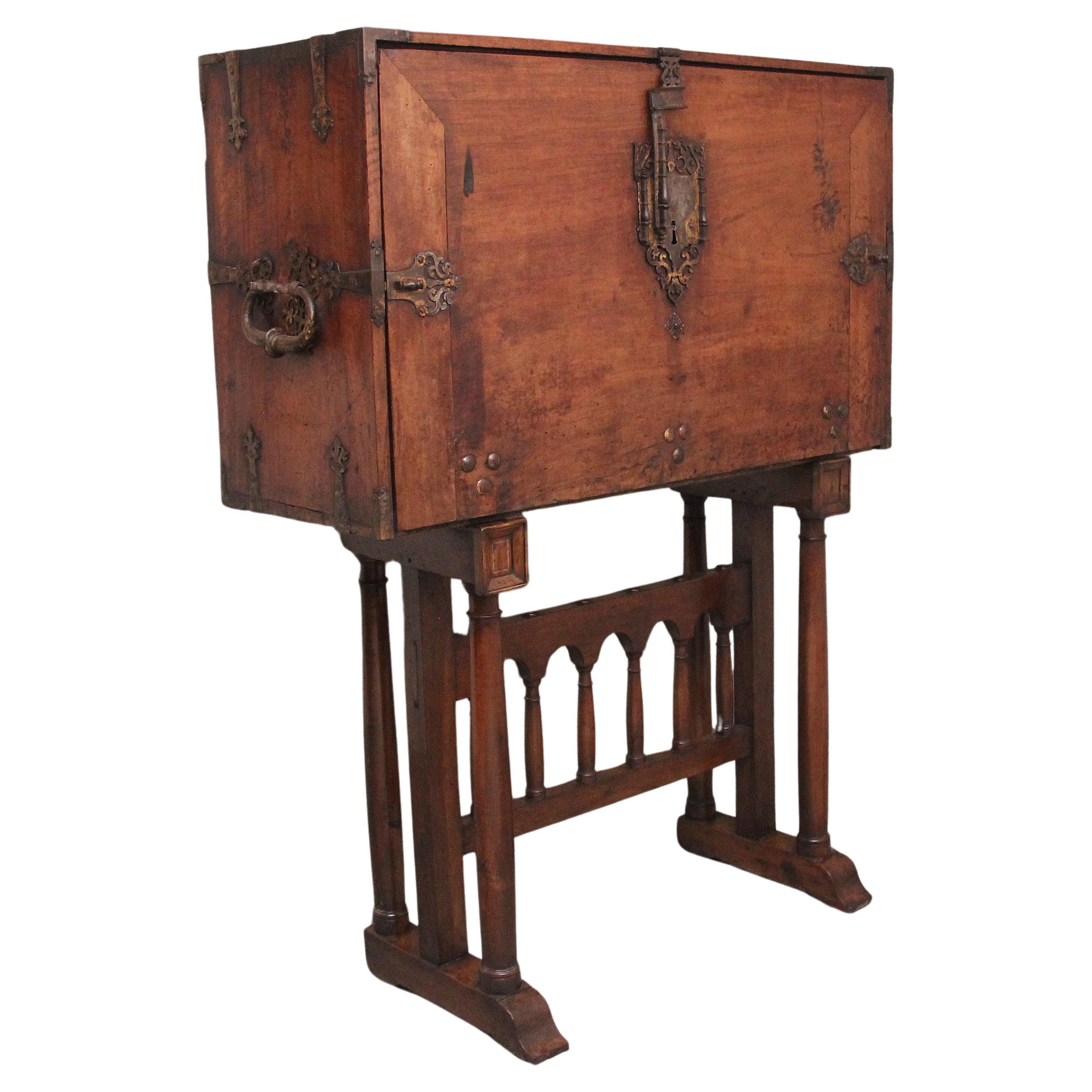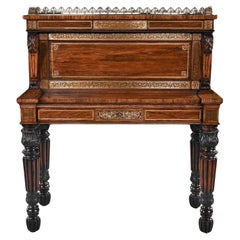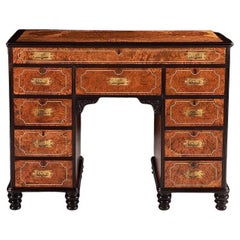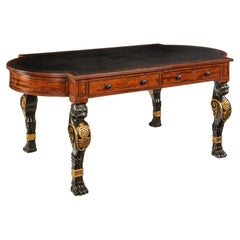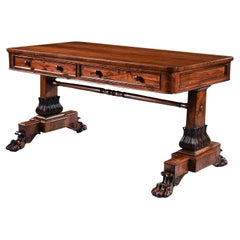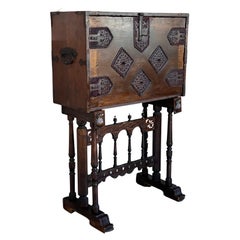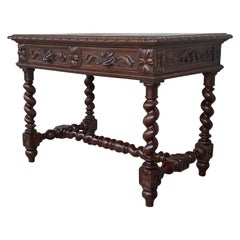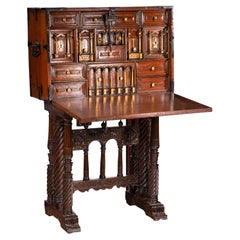Items Similar to Exceptional Early 17th Century Spanish Walnut Vargueno Desk on Stand
Want more images or videos?
Request additional images or videos from the seller
1 of 17
Exceptional Early 17th Century Spanish Walnut Vargueno Desk on Stand
$19,989.86
£14,500
€16,932.31
CA$27,639.54
A$30,344.77
CHF 15,830.93
MX$367,213.99
NOK 198,416.16
SEK 186,960.19
DKK 126,395.21
About the Item
An exceptionally fine example of an early 17th Century Spanish renaissance walnut vargueno / bargueno escritorio writing desk on trestle stand.
Spain, Salamanca circa 1600-1630.
This wonderful vargueno is one of the finest we have seen retaining its original cut velvet, gilt iron metal work and key, housed on an early 19th century trestle stand possibly having earlier elements.
The vargueno or bargueno is so called because it was thought to have originated in the village of Bargas in the province of Toledo. It is the earliest form of a writing desk known and was conceived to show the expertise of the Spanish craftsman having such an opulent carved and gilded interior. Spain’s outstanding contribution to the development of European furniture is this cabinet.
Although extremely heavy they were used as a travelling desk within the Spanish global empire and were highly prized as an object of status within the Spanish Courts.
The rectangular walnut cabinet, constructed with fine cuts of dense walnut, having a fall front with velvet-lined pierced and gilt wrought-iron handles, hinges and an elaborate lock and hasp, enclosing a fitted interior with an arrangement of drawers, secret drawers and doors with elaborate parcel-gilt, painted, carved and twisted bone columns, medallions and architectural decoration. The whole housed on an early 19th Century or possibly late 18th century stand or puente with an arcade, ropetwist and baluster uprights above carved sledge feet, the shell carved pulls slide out to support the writing leaf.
It is extremely rare to find a Vargueno retaining areas of the original gilt to the exterior iron work and velvet in such good condition and colour, making this one of finest you will see.
The original shaped iron key locks the central elaborate double hasp which is attached to the top is lifted to stand vertical when in use. There are two sliding bolts to each side housed within pierced metal mounts having decorative lions, which are used to secure the fall front when unlocked and a further two swinging catches to the top. The sides are fitted with carrying handles within hexagon pierced metal mounts.
Similar pieces can be found in the Victoria and Albert Museum (V&A) below…
Also in the Boston Museum of Fine Arts accession number 1990.614a
Images shown are of a Vargueno in Domenech & Perez Bueno publication Antique Spanish Furniture.
Many varguenos in these books are in private collections or museums.
Dimensions
Width 41 inches - 104cm
Height 56 inches - 142cm
Depth 18 inches - 46cm.
- Dimensions:Height: 55.91 in (142 cm)Width: 40.95 in (104 cm)Depth: 19.3 in (49 cm)
- Style:Renaissance (In the Style Of)
- Materials and Techniques:Walnut
- Place of Origin:Spain
- Period:17th Century
- Date of Manufacture:1600-1630
- Condition:Wear consistent with age and use.
- Seller Location:Benington, GB
- Reference Number:Seller: 28581stDibs: LU1183228706362
About the Seller
5.0
Gold Seller
Premium sellers maintaining a 4.3+ rating and 24-hour response times
Established in 1969
1stDibs seller since 2015
128 sales on 1stDibs
Typical response time: 5 hours
Associations
LAPADA - The Association of Arts & Antiques DealersThe British Antique Dealers' Association
- ShippingRetrieving quote...Shipping from: Benington, United Kingdom
- Return Policy
Authenticity Guarantee
In the unlikely event there’s an issue with an item’s authenticity, contact us within 1 year for a full refund. DetailsMoney-Back Guarantee
If your item is not as described, is damaged in transit, or does not arrive, contact us within 7 days for a full refund. Details24-Hour Cancellation
You have a 24-hour grace period in which to reconsider your purchase, with no questions asked.Vetted Professional Sellers
Our world-class sellers must adhere to strict standards for service and quality, maintaining the integrity of our listings.Price-Match Guarantee
If you find that a seller listed the same item for a lower price elsewhere, we’ll match it.Trusted Global Delivery
Our best-in-class carrier network provides specialized shipping options worldwide, including custom delivery.More From This Seller
View AllAn Extremely Fine Rosewood and Brass Inlaid Writing Table Attributed To Gillows
By Gillows of Lancaster & London
Located in Benington, Herts
An Extremely Fine and rare Rosewood and Brass Inlaid Writing Table Attributed to the Oxford Street Workshop of Gillows.
English c.1820-1830
With a raised back comprising a thre...
Category
Antique Early 19th Century English Desks and Writing Tables
Materials
Brass
Rare Chinese Export Amboyna and Ebony Campaign Kneehole Desk
Located in Benington, Herts
Rare and outstanding example of an early 19th century Anglo-Chinese export amboyna and ebony campaign kneehole desk retaining the original patina with wonderful colour.
China circa 1830
One of the finest examples you will see, constructed using thick hand sawn cuts of amboyna and solid ebony with ivory stringing and countersunk brass pulls to the camphor wood lined drawers, having brass drop carrying handles to each side. The rectangular top with book matched amboyna veneers enclosed by a solid ebony boarder above a frieze drawer fitted with an adjustable inset velvet lined writing slope flanked by multiple sliding lidded compartments and pen rests.
Below is an arrangement of nine ivory strung drawers and a kneehole recess with foliate carved and pierced ankle brackets, the whole being raised on eight solid ebony turned feet.
This impressive colonial inspired desk is Chinese and would have been intended for the export market. Some years back this desk was often mistaken to have been Anglo-Indian due to the fact it shares many characteristics of Indian furniture...
Category
Antique 1830s Chinese Desks
Materials
Ebony, Amboyna
Important Regency Mahogany Partners Writing Table in the Manner of George Smith
By George Smith, Charles Norman
Located in Benington, Herts
A highly Important, Regency period mahogany, ebonised and parcel-gilt partners writing table on monopodia legs of exceptional quality and design, in the manner of George Smith, stamped Chas Norman, whom was associated with the work of Gillows.
Labelled ‘Morning Room’.
English, Regency period, circa 1810-20.
Rarely seen, the crescent shaped ended rectangular top, beautifully lined with the original gilt tooled leather writing surface, enclosed by a mahogany cross-banded border and reeded edge.
The frieze, containing four finely chosen fiddle-back mahogany drawers, two pairs to opposing sides, each retaining the original gadrooned carved ebonised knob handles. The perimeters having a finely ebonised cockbead, whilst the drawer liners being executed in mahogany retain the original recessed brass locks, which look to have never been removed. Flanking the drawers are bead-moulded ebonised panels which conform to either end above a reeded mould.
Raised on four boldly designed and imposing, crisply carved, ebonised and parcel-gilt leopard monopodia supports, of wonderful original waxed condition. The Egyptian leopards mask above a bold breast decorated with carved gilt anthemion and guilloche motifs, finishing on a finely detailed carved leg and paw foot.
The condition is excellent, retaining the original hand-dyed and gilt tooled waxed leather writing surface along with original locks, handles and ebonising with gilt-work to the legs. Commissioned for what presumes to be a private collection and due to its condition, being obvious to see, this writing table has been home to an important household. Labelled ‘Morning Library’ to the underside, whilst in this exemplary condition strongly suggests this striking piece of Regency furniture has furnished the library of the said house for the majority of its life.
As can be noted, this is an extremely rare, elegant, early Regency writing table of exceptional colour, which corresponds with designs of the celebrated furniture maker and designer George Smith, workmanship of Gillows, being stamped to the underside Chas Norman four times.
George Smith (1756 - 1826) was one of the most influential furniture designers of the English Regency Period (1811-1830). Smith, who began his pattern-book in 1804, wrote of ‘the great taste and elegance’ of this design.
In 1808 he published his influential and definitive text on Regency interior Design titled ‘ A Collection of Designs for Household Furniture and Interior Decoration’ and classed himself as ‘Upholder Extraordinary to His Royal Excellency the Prince of Wales’…The Prince Regent.
Smith was inspired in his designs from his earlier career as an Egyptologist, producing drawings incorporating motifs of Leopards heads and paws, Lions, sphinx’s, anthemia, and griffons amongst others.
Charles Heathcote Tatham (1772-1842) published ‘Etchings, Representing the Best Examples of Ancient Ornamental Architecture; Drawn from the Originals in Rome, and Other Parts of Italy During the Years 1794, 1795, and 1796’, in which he illustrated an antique tripod table...
Category
Antique Early 19th Century British Regency Desks and Writing Tables
Materials
Mahogany, Giltwood
$28,950 Sale Price
50% Off
George IV Period Rosewood Library Table With Carved Lions Paw Feet
Located in Benington, Herts
A George IV Period Rosewood Library Table With Carved Lions Paw Feet
English Circa 1820- 1830
This handsome table would have been commissioned for a grand library or study. The ov...
Category
Antique Mid-19th Century English George IV Side Tables
Materials
Rosewood
Exceptional Quality Pollard Oak Mid-19th Century Sideboard
Located in Benington, Herts
An exceptional quality and rare pollard oak 19th century architectural twin pedestal inverted breakfront sideboard.
English, circa 1850.
The quarter cut inverted breakfront top...
Category
Antique Mid-19th Century English Victorian Sideboards
Materials
Oak, Burl
Imposing 17th Century Portuguese Colonial Mahogany and Brass Chest
Located in Benington, Herts
An imposing 17th century mahogany Portuguese colonial trunk / chest, of grand proportions, decorated with pierced brass panels.
Probably Brazil, circa 1670.
This rare chest...
Category
Antique Late 17th Century Brazilian Trunks and Luggage
Materials
Brass, Iron
You May Also Like
19th Century Cuban Mahogany Wood Bargueno Desk
Located in Guaynabo, PR
This Bargueno desk is hallmarked Garcia & HN Monte #122 Habana. It is embellished with a carving scene from the book of Don Quixote de la Mancha bordered...
Category
Antique Late 19th Century American Renaissance Revival Secretaires
Materials
Wood
$8,800 Sale Price
58% Off
17th Spanish Walnut Cabinet on Stand, Desk, Original ‘Bargueño’
Located in Miami, FL
Spanish desk (“bargueño”) in walnut.
17th century with “bridge-shapped”. Decorated on the exterior with metal applications (open-work, textile background) and bow handles with centr...
Category
Antique 17th Century Spanish Baroque Cabinets
Materials
Walnut
19th Spanish Walnut Desk with Two Drawers and Solomonic Turning Legs
Located in Miami, FL
19th Spanish walnut desk with two drawers and solomonic turning legs and solomonic stretcher
it is carved in four sides
It has a central lock for...
Category
Antique 1890s French Baroque Desks and Writing Tables
Materials
Iron
$4,320 Sale Price
20% Off
Bargueño or desk with bridge base. Wood, metal. Spanish school, 17th c
Located in Madrid, ES
Bargueño or wastepaper basket with bridge base. Wood, metal. Spanish school, 17th century.
In need of some restoration.
Bargueño or covered waste-paper basket placed on a support ...
Category
Antique 17th Century Spanish Baroque Desks
Materials
Other
Spanish Baroque Period Walnut 1-Drawer Desk or Work Table, Late 17th Century
Located in Atlanta, GA
having a rectangular top with with one "floating" carved drawer below it, the top supported by trestle form legs joined by diagonal stretchers and two horizontal centered stretchers
Category
Antique 1670s Spanish Baroque Desks and Writing Tables
Materials
Walnut
17th Century walnut Vargueno on stand
Located in Martlesham, GB
A superb quality 17th Century walnut Vargueno on stand, the rectangular case having the original iron carrying handles either side and strapwork decoration, the front having a shield...
Category
Antique 1690s Spanish Cabinets
Materials
Walnut
$7,665 Sale Price
20% Off
More Ways To Browse
18th Century Spanish Side Table
Antique Traveling Desk
Spanish Trestle
Antique Sledge
Architectural Medallions
17th Spanish Walnut Table
Antique Carved Walnut Trestle Table
17th Century Spanish Desk
Bargueno Desk
17th Century Vargueno
Spanish 18th Century Vargueno Cabinet
Antique Slide Bolt
Spanish Renaissance Vargueno
Campaign Tables With Brass
Gustav Stickley Copper
Gustav Stickley Desk
Japanese Wood Desk
Japanese Writing Desk
